Popular categories
Looking for a yarn?

75% Wool, 25% Polyamide
from 2.50 € /50g
Order DROPS Kid-Silk from Camellia

|
DROPS Kid-Silk uni colour 75% Mohair, 25% Silk |
5.05 € /25g |
Order |
Clicking the ORDER button will redirect you to Camellia website
The yarn cost is calculated from the pattern’s smallest size and the yarn’s cheapest product type. Looking for an even better price? You might find it on the DROPS Deals!
River Reflections
Knitted vest / slipover in 1 strand DROPS Fabel and 1 strand Kid-Silk. Piece is knitted in stocking stitch with edges in rib. Size: S - XXXL
DROPS design: Pattern no FA-460
Yarn group A + A or C
-------------------------------------------------------
SIZE:
S - M - L - XL - XXL - XXXL
MATERIALS:
DROPS Fabel from Garnstudio (belongs to yarn group A)
150-150-150-200-200-200 g colour no 604, ocean view
And use:
DROPS Kid-Silk from Garnstudio (belongs to yarn group A
50-75-75-75-75-100 g colour no 10, grey
KNITTING TENSION:
17 stitches in width and 22 rows vertically in stocking stitch and 1 strand of each quality (= 2 strands)= 10 x 10 cm.
NEEDLES:
DROPS CIRCULAR NEEDLE SIZE 5 mm : Length 60 or 80 cm for edges in stocking stitch.
DROPS DOUBLE POINTED NEEDLES SIZE 4 mm
DROPS CIRCULAR NEEDLE SIZE 4 mm : Length 40 or 60 cm for rib.
Needle size is only a suggestion! If you have too many stitches on 10 cm switch to a larger needle size. If you have too few stitches on 10 cm switch to a smaller needle size.
-------------------------------------------------------
Alternative Yarn – See how to change yarns here
Yarn Groups A to F – Use the same pattern and change the yarn here
Yarn usage using an alternative yarn – Use our yarn converter here
-------------------------------------------------------

75% Wool, 25% Polyamide
from 2.50 € /50g
Order DROPS Fabel from Camellia

|
DROPS Kid-Silk uni colour 75% Mohair, 25% Silk 5.05 € /25g Order |
Clicking the ORDER button will redirect you to Camellia website
The yarn cost is calculated from the pattern’s smallest size and the yarn’s cheapest product type. Looking for an even better price? You might find it on the DROPS Deals!
- English (UK/cm), Latvia
- Česky
- Dansk
- Deutsch
- Eesti keel
- English (UK/cm)
- English (US/in)
- Español
- Français
- Íslenska
- Italiano
- Magyar
- Nederlands
- Norsk
- Polski
- Português
- Suomi
- Svenska
- English (UK/cm), Bulgaria
- English (UK/cm), Croatia
- English (UK/cm), Greece
- English (UK/cm), Lithuania
- English (UK/cm), Romania
- English (UK/cm), Slovenia
- Česky, Slovakia
Pattern instructions
EXPLANATION FOR THE PATTERN:
-------------------------------------------------------
GARTER STITCH (back and forth):
Knit all rows.
DECREASE TIP (evenly):
To calculate how to decrease evenly, use the total number of stitches on row (e.g. 89 stitches) and divide stitches by number of decreases to be done (e.g. 15) = 5.9. In this example work approx. every 5th and 6th stitch together.
-------------------------------------------------------
START THE PIECE HERE:
-------------------------------------------------------
VEST - SHORT OVERVIEW OF THE PIECE:
Work front pieces and back piece separately back and forth, bottom up. Back piece is 4 cm longer than front piece. Work edges around the armholes and neck in the round on circular needle or double pointed needles.
FRONT PIECE:
Cast on 89-97-103-111-121-131 stitches on needle size 4 mm with 1 strand Fabel and 1 strand Kid-Silk (= 2 strands). Knit 1 row from right side.
Work rib as follows from next row: 1 edge stitch in GARTER STITCH – read explanation above, knit 1 and purl 1 until 1 stitch remains on needle, 1 edge stitch in garter stitch.
Work until rib measures approx. 10 cm in all sizes.
Switch to needle size 5 mm. Now work in stocking stitch and on first row decrease 15 stitches evenly in all sizes - read DECREASE TIP in explanation above = 74-82-88-96-106-116 stitches.
REMEMBER THE KNITTING TENSION!
Work until piece measures 20-21-22-23-24-25 cm from cast-on edge.
On next row cast off for armholes in each side as follows: Cast off 3-3-3-4-4-4 stitches 1 time, 2 stitches 1 time, and 1 stitch 1-3-4-6-9-12 times = 62-66-70-72-76-80 stitches.
Work until piece measures 34-36-36-38-38-40 cm (approx. 10-10-12-12-14-14 cm until finished measurements).
On next row from right side cast off for neck as follows: Work 25-27-28-29-30-32 stitches, cast off the next 12-12-14-14-16-16 stitches for neck, and work the last 25-27-28-29-30-32 stitches. Work shoulder separately, do not cut the strand - work right shoulder from the wrong side from here.
RIGHT SHOULDER FRONT PIECE:
= 25-27-28-29-30-32 stitches.
Work stocking stitch, begin from wrong side, and cast off stitches for neck at the beginning of rows from right side as follows: Cast off 2 stitches 2 times, and cast off 1 stitch 4 times = 17-19-20-21-22-24 stitches.
Work until piece measures total 44-46-48-50-52-54 cm in total from cast-on edge. Cast off and fasten the yarn.
LEFT SHOULDER FRONT PIECE:
= 25-27-28-29-30-32 stitches.
Work stocking stitch, begin from right side, and cast off for neck at the beginning of rows from wrong side as follows: Cast off 2 stitches 2 times, and cast off 1 stitch 4 times = 17-19-20-21-22-24 stitches.
Work until piece measures total 44-46-48-50-52-54 cm in total from cast-on edge, adjust according to left shoulder. Cast off and fasten the yarn.
BACK PIECE:
Cast on 89-97-103-111-121-131 stitches on needle size 4 mm with 1 strand Fabel and 1 strand Kid-Silk (= 2 strands). Knit 1 row from right side. Work rib as follows from next row: 1 edge stitch in garter stitch, knit 1 and purl 1 until 1 stitch remains, 1 edge stitch in garter stitch.
Work until rib measures approx. 14 cm in all sizes.
Switch to needle size 5 mm. Now work in stocking stitch and on first row decrease 15 stitches evenly in all sizes - read DECREASE TIP in explanation above = 74-82-88-96-106-116 stitches.
Work until piece measures 24-25-26-27-28-29 cm from cast-on edge.
On next row cast off for armholes in each side as follows: Cast off 3-3-3-4-4-4 stitches 1 time, 2 stitches 1 time, and cast off 1 stitch 1-3-4-6-9-12 times = 62-66-70-72-76-80 stitches.
Work until piece measures 44-46-48-50-52-54 cm (approx. 4 cm remain until finished measurements).
On next row from right side cast off for neck as follows: Work the first 18-20-21-22-23-25 stitches, cast off the next 26-26-28-28-30-30 stitches for neck, and work the last 18-20-21-22-23-25 stitches. Work shoulder separately, do not cut the strand - work left shoulder from the wrong side from here.
LEFT SHOULDER BACK PIECE:
= 18-20-21-22-23-25 stitches.
Work in stocking stitch, begin from wrong side and cast off 1 stitch at the beginning of next row from the right side = 17-19-20-21-22-24 stitches. Work until piece measures approx. 48-50-52-54-56-58 cm in total from cast-on edge, adjust according to front pieces: Cast off and fasten the yarn.
RIGHT SHOULDER BACK PIECE:
= 18-20-21-22-23-25 stitches.
Work in stocking stitch, begin from right side and cast off 1 stitch at the beginning of next row from wrong side = 17-19-20-21-22-24 stitches. Work until piece measures approx. 48-50-52-54-56-58 cm in total from cast-on edge, adjust according to front pieces: Cast off and fasten the yarn.
ASSEMBLY:
Sew shoulder seams edge to edge. Sew side seams, begin at armhole and sew down until 1 cm of rib - from here there is a vent, and back piece is longer than front piece.
NECK EDGE:
Begin from right side at one shoulder seam with 1 strand Fabel and 1 strand Kid-Silk. Use circular needle or double pointed needles size 4 mm and pick up approx. 80 to 100 stitches inside 1 stitch around the entire opening (number of stitch must be divisible by 2). Work rib in the round (knit 1/purl 1) in the round until rib measures 5 cm. Cast off stitches with knit over knit and purl over purl.
EDGE AROUND ARMHOLES:
Begin from right side where armholes was cast off with 1 strand Fabel and 1 strand Kid-Silk. Use circular needle or double pointed needles size 4 mm and pick up approx. 110 to 134 stitches around the entire armhole (number of stitches must be divisible by 2). Work rib in round with knit 1 and purl 1 until rib measures 4 cm. Cast off stitches with knit over knit and purl over purl.
Work an edge around the other armhole the same way.
Diagram
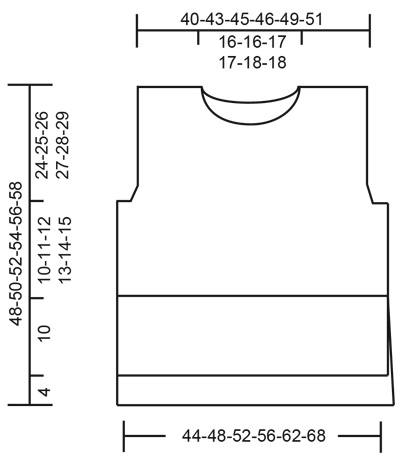
What can you do with our patterns? You can share DROPS patterns online, using the pattern original picture, materials, name and number. But you are NOT ALLOWED to reproduce the complete pattern digitally in any way. Yarn stores are welcome to use the DROPS pattern database to promote the sale of our assortment. You can print out our patterns, make as many copies as you’d like. The only thing we ask is that you don't make any changes / additions to the original printed document. And that the patterns according to the DROPS philosophy are given out to the consumers for free. Editorials that wish to publish our patterns in printed books or magazines can contact us for more information. The sale of garments based on DROPS patterns is permitted as long as they are sold as single items or per order. Further commercial use of the patterns is not permitted. It has to be clearly stated that the garment is made based on a design from DROPS DESIGN. The use of clothing labels of which DROPS DESIGN forms part is conditioned by the inclusion of the following text: “A DROPS DESIGN made by …..”. The use of DROPS photos for marketing purposes/sales is only permitted in connection with the use/sale of DROPS products. The photos may not be cut or edited and the logo should be clearly visible.
We reserve the right to withdraw the permission for use of our patterns at any time, notwithstanding the reason.
Each of our patterns has specific tutorial videos to help you.
These step-by-step tutorials might also help you:
Why is the knitting/crochet tension so important?
Knitting tension is what determines the final measurements of your work, and is usually measured per 10 x 10 cm. It is provided like so: number of stitches in width x number of rows in height - eg: 19 stitches x 26 rows = 10 x 10 cm.
The knitting tension is very individual; some people knit/crochet loosely while others work tightly. You adjust the knitting tension with the needle size, which is why the suggested needle size is only meant as a guide! You need to adjust this (up or down) to ensure that YOUR knitting tension matches the knitting tension provided in the pattern. If you work with a different knitting tension than provided you will have a different yarn consumption, and your work will have different measurements than what the pattern suggests.
The knitting tension also determines which yarns can replace each other. As long as you achieve the same knitting tension you can replace one yarn with another.
See DROPS lesson: How to measure your tension/gauge
See DROPS video: How to make a gauge tension swatch
How do I know how many balls of yarn I need?
The required amount of yarn is provided in grams, eg: 450 g. To calculate how many balls you’ll need you first need to know how many grams are in 1 ball (25g, 50g or 100g). This information is available if you click on the individual yarn quality on our pages. Divide the amount required with the amount of each ball. For example, if each ball is 50g (the most common amount), the calculation will be as follows: 450 / 50 = 9 balls.
Can I use a different yarn than what the pattern suggests?
The important thing when changing from one yarn to another is that the knitting/crochet tension remains the same. This is so that the measurements of the finished piece will be the same as on the sketch provided. It is easier to achieve the same knitting tension using yarns from the same yarn group. It is also possible to work with multiple strands of a thinner yarn to achieve the knitting tension of a thicker one. Please try our yarn converter. We recommend you to always work a test swatch.
Please NOTE: when changing yarn the garment might have a different look and feel to the garment in the photo, due to individual properties and qualities of each yarn.
See DROPS lesson: Can I use a different yarn than the one mentioned in the pattern?
What are the yarn groups?
All our yarns are categorised into yarn groups (from A to F) according to thickness and knitting tension – group A contains the thinnest yarns and group F the thickest. This makes it easier for you to find alternative yarns to our patterns, should you wish to switch yarn. All yarns within the same group have a similar knitting tension and can easily replace each other. However, different yarn qualities have different structures and properties which will give the finished work a unique look and feel.
How do I use the yarn calculator?
At the top of all our patterns you’ll find a link to our yarn calculator, which is a helpful tool should you wish to use a different yarn than suggested. By filling in the yarn quality you wish to replace, the amount (in your size) and number of strands, the calculator will present good alternative yarns with the same knitting tension. Additionally it will tell you how much you’ll require in the new qualities and whether you’ll need to work with multiple strands. Most skeins are 50g (some are 25g or 100g).
If the pattern is worked with multiple colours, every colour will have to be calculated separately. Similarly, if the pattern is worked with several strands of different yarns (for example 1 strand Alpaca and 1 strand Kid-Silk) you will have to find alternatives for each, individually.
Why do you show discontinued yarns in the patterns?
Since different yarns have different qualities and textures we have chosen to keep the original yarn in our patterns. However, you can easily find options among our available qualities by using our yarn calculator, or simply pick a yarn from the same yarn group.
It is possible that some retailers still have discontinued yarns in stock, or that someone has a few skeins at home that they would like to find patterns for.
The yarn calculator will provide both alternative yarn as well as required amount in the new quality.
What size should I knit?
If you think it's hard to decide what size to make, it can be a good idea to measure a garment you own already and like the size of. Then you can pick the size by comparing those measures with the ones available in the pattern's size chart.
You'll find the size chart at the bottom of the pattern.
See DROPS lesson: How to read size chart
Why do I get the wrong knitting tension with the suggested needle size?
The needle size provided in the pattern serves only as a guide, the important thing is to follow the knitting tension. And since knitting tension is very individual, you will have to adjust the needle size to ensure that YOUR tension is the same as in the pattern – maybe you’ll have to adjust 1, or even 2 needle sizes, up or down to achieve the correct tension. For this, we recommend that you work test swatches.
Should you work with a different knitting tension than the one provided, the measurements of the finished garment might deviate from the measurement sketch.
See DROPS lesson: How to measure your tension/gauge
See DROPS video: How to make a tension/gauge swatch
Why is the pattern worked top-down?
Working a garment top-down provides more flexibility and room for personal adjustment. For example it is easier to try the garment on while working, as well as making adjustments to length of yoke and shoulder caps.
The instructions are carefully explaining every step, in the correct order. Diagrams are adjusted to the knitting direction and are worked as usual.
How do I work according to a knitting diagram?
The diagram depicts all rows/rounds, and every stitch seen from the right side. It is read from bottom to top, from right to left. 1 square = 1 stitch.
When working back and forth, every other row is worked from the right side and every other row is worked from the wrong side. When working from the wrong side, the diagram will have to be worked reversed: from left to right, knit stitches are purled, purl stitches are knit etc.
When working in the round every round is worked from the right side and the diagram are worked from right to left on all rounds.
See DROPS lesson: How to read knitting diagrams
How do I work according to a crochet diagram?
The diagram depicts all rows/rounds, and every stitch seen from the right side. It is worked from bottom to top, from right to left.
When working back and forth every other row is worked from the right side: from right to left and every other row is worked from the wrong side: from left to right.
When working in the round, every row in the diagram are worked from the right side, from right to left.
When working a circular diagram you start in the middle and work your way outwards, counter clockwise, row by row.
The rows usually start with a given number of chain stitches (equivalent to the height of the following stitch), this will either be depicted in the diagram or explained in the pattern.
See DROPS lesson: How to read crochet diagrams
How do I work several diagrams simultaneously on the same row/round?
Instructions for working several diagrams after each other on the same row/round, will often be written like so: “work A.1, A.2, A.3 a total of 0-0-2-3-4 times". This means you work A.1 once, then A.2 is worked once, and A.3 is repeated (in width) the number of times provided for your size – in this case like so: S = 0 times, M = 0 times, L=2 times, XL= 3 times and XXL = 4 times.
The diagrams are worked as usual: begin with the first row in A.1, then work the first row in A.2 etc.
See DROPS lesson: How to read knitting diagrams
See DROPS lesson: How to read crochet diagrams
Why are the sleeves shorter in larger sizes?
The total width of the garment (from wrist-to-wrist) will be larger in the larger sizes, despite the actual sleeves being shorter. The larger sizes have longer sleeve caps and wider shoulders, so there will be a good fit in all sizes.
Where on the garment is the length measured?
The measurement sketch/schematic drawing provides information regarding the full length of the garment. If it’s a jumper or a jacket the length is measured from the highest point on the shoulder closest to the neckline, and straight down to the bottom of the garment. It is NOT measured from the tip of shoulder. Similarly, the length of yoke is measured from the highest point on the shoulder and down to where yoke is split into body and sleeves.
On a jacket measures are never taken along bands, unless specifically stated. Always measure inside band stitches when measuring the length.
See DROPS lesson: How to read a schematic drawing
What is a repeat?
Diagrams are often repeated on the round or in height. 1 repeat is the diagram the way it appears in the pattern. If it says to work 5 repeats of A.1 in the round, then you work A.1 a total of 5 times after/next to each other in the round. If it says to work 2 repeats of A.1 vertically/in height you work the entire diagram once, then begin again at the start and work the entire diagram one more time.
Why does the piece start with more chain stitches than it’s worked with?
Chain stitches are slightly narrower than other stitches and to avoid working the cast-on edge too tight, we simply chain more stitches to begin with. The stitch count will be adjusted on the following row to fit the pattern and measurement sketch.
Why increase before the rib edge when the piece is worked top-down?
The rib edge is more elastic and will contract slightly compared to, for example, stocking stitch. By increasing before the rib edge, you avoid a visible difference in width between the rib edge and the rest of the body.
Why increase in the cast-off edge?
It’s very easy to cast off too tightly, and by making yarn overs while casting off (and simultaneously casting these off) you avoid a too tight cast off edge.
See DROPS video: How to bind off with yarn overs (yo)
How do I increase/decrease on every 3rd and 4th row/round alternately?
To achieve an even increase (or decrease) you can increase on, for example: every 3rd and 4th row alternately, like so: work 2 rows and increase on the 3rd row, work 3 rows and increase on the 4th. Repeat this until the increase is complete.
See DROPS lesson: Increase or decrease 1 st on every 3rd and 4th row alternately
How can I work a jacket in the round instead of back and forth?
Should you prefer to work in the round instead of back and forth, you may of course adjust the pattern. You’ll need to add steeks mid-front (usually 5 stitches), and follow the instructions. When you would normally turn and work from the wrong side, simply work across the steek and continue in the round. At the end you’ll cut the piece open, pick up stitches to work bands, and cover the cut edges.
See DROPS video: How to knit steeks and cut open
Can I work a jumper back and forth instead of in the round?
Should you prefer to work back and forth instead of in the round, you may of course adjust the pattern so you work the pieces separately and then assemble them at the end. Divide the stitches for the body in 2, add 1 edge stitch in each side (for sewing) and work the front and back pieces separately.
See DROPS lesson: Can I adapt a pattern for circular needles into straight needles?
Why is the pattern slightly different than what I see in the photo?
Pattern repeats can vary slightly in the different sizes, in order to get the correct proportions. If you’re not working the exact same size as the garment in the photo, yours might deviate slightly. This has been carefully developed and adjusted so that the complete impression of the garment is the same in all sizes.
Make sure to follow instructions and diagrams for your size!
How do I make a women’s size garment into a men’s size one?
If you have found a pattern you like which is available in women’s size it’s not very difficult to convert it to men’s size. The biggest difference will be the length of sleeves and body. Start working on the women size that you think would fit across the chest. The additional length will be worked right before you cast off for the armhole/sleeve cap. If the pattern is worked top-down you can add the length right after the armhole or before the first decrease on sleeve.
Regarding additional yarn amount, this will depend on how much length you add, but it is better with a skein too many than too few.
How do I prevent a hairy garment from shedding?
All yarns will have excess fibres (from production) that might come off as lint or shedding. Brushed yarns (ie hairier yarns) have more of these loose, excess fibres, causing more shedding.
Shedding also depends on what is worn under or over the garment, and whether this pulls at the yarn fibres. It’s therefore not possible to guarantee that there will be no shedding
Below are some tips on how to get the best result when working with hairier yarns:
1. When the garment is finished (before you wash it) shake it vigorously so the looser hairs come off. NOTE: do NOT use a lint roller, brush or any method that pulls at the yarn.
2. Place the garment in a plastic bag and put it in your freezer - the temperature will cause the fibres to become less attached to each other, and excess fibres will come off easier.
3. Leave in the freezer for a few hours before taking it out and shaking it again.
4. Wash the garment according to the instructions on the yarn label.
Why does my garment pill?
Pilling is a natural process that happens to even the most exclusive of fibers. It's a natural sign of wear and tear that is hard to avoid, and that is most visible in high friction areas of your garment like a sweater's arms and cuffs.
You can make your garment look as new by removing the pilling, using a fabric comb or a pill/lint remover.
In the meantime, you can read the questions and answers that others have left to this pattern or join the DROPS Workshop on Facebook to get help from fellow knitters/crocheters!
You might also like...
River Reflections |
|
 |
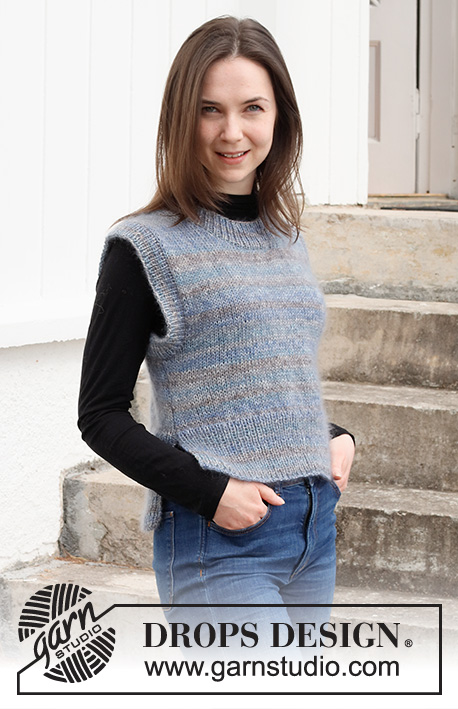 |
Knitted vest / slipover in 1 strand DROPS Fabel and 1 strand Kid-Silk. Piece is knitted in stocking stitch with edges in rib. Size: S - XXXL
DROPS 216-33 |
|
|
------------------------------------------------------- EXPLANATION FOR THE PATTERN: ------------------------------------------------------- GARTER STITCH (back and forth): Knit all rows. DECREASE TIP (evenly): To calculate how to decrease evenly, use the total number of stitches on row (e.g. 89 stitches) and divide stitches by number of decreases to be done (e.g. 15) = 5.9. In this example work approx. every 5th and 6th stitch together. ------------------------------------------------------- START THE PIECE HERE: ------------------------------------------------------- VEST - SHORT OVERVIEW OF THE PIECE: Work front pieces and back piece separately back and forth, bottom up. Back piece is 4 cm longer than front piece. Work edges around the armholes and neck in the round on circular needle or double pointed needles. FRONT PIECE: Cast on 89-97-103-111-121-131 stitches on needle size 4 mm with 1 strand Fabel and 1 strand Kid-Silk (= 2 strands). Knit 1 row from right side. Work rib as follows from next row: 1 edge stitch in GARTER STITCH – read explanation above, knit 1 and purl 1 until 1 stitch remains on needle, 1 edge stitch in garter stitch. Work until rib measures approx. 10 cm in all sizes. Switch to needle size 5 mm. Now work in stocking stitch and on first row decrease 15 stitches evenly in all sizes - read DECREASE TIP in explanation above = 74-82-88-96-106-116 stitches. REMEMBER THE KNITTING TENSION! Work until piece measures 20-21-22-23-24-25 cm from cast-on edge. On next row cast off for armholes in each side as follows: Cast off 3-3-3-4-4-4 stitches 1 time, 2 stitches 1 time, and 1 stitch 1-3-4-6-9-12 times = 62-66-70-72-76-80 stitches. Work until piece measures 34-36-36-38-38-40 cm (approx. 10-10-12-12-14-14 cm until finished measurements). On next row from right side cast off for neck as follows: Work 25-27-28-29-30-32 stitches, cast off the next 12-12-14-14-16-16 stitches for neck, and work the last 25-27-28-29-30-32 stitches. Work shoulder separately, do not cut the strand - work right shoulder from the wrong side from here. RIGHT SHOULDER FRONT PIECE: = 25-27-28-29-30-32 stitches. Work stocking stitch, begin from wrong side, and cast off stitches for neck at the beginning of rows from right side as follows: Cast off 2 stitches 2 times, and cast off 1 stitch 4 times = 17-19-20-21-22-24 stitches. Work until piece measures total 44-46-48-50-52-54 cm in total from cast-on edge. Cast off and fasten the yarn. LEFT SHOULDER FRONT PIECE: = 25-27-28-29-30-32 stitches. Work stocking stitch, begin from right side, and cast off for neck at the beginning of rows from wrong side as follows: Cast off 2 stitches 2 times, and cast off 1 stitch 4 times = 17-19-20-21-22-24 stitches. Work until piece measures total 44-46-48-50-52-54 cm in total from cast-on edge, adjust according to left shoulder. Cast off and fasten the yarn. BACK PIECE: Cast on 89-97-103-111-121-131 stitches on needle size 4 mm with 1 strand Fabel and 1 strand Kid-Silk (= 2 strands). Knit 1 row from right side. Work rib as follows from next row: 1 edge stitch in garter stitch, knit 1 and purl 1 until 1 stitch remains, 1 edge stitch in garter stitch. Work until rib measures approx. 14 cm in all sizes. Switch to needle size 5 mm. Now work in stocking stitch and on first row decrease 15 stitches evenly in all sizes - read DECREASE TIP in explanation above = 74-82-88-96-106-116 stitches. Work until piece measures 24-25-26-27-28-29 cm from cast-on edge. On next row cast off for armholes in each side as follows: Cast off 3-3-3-4-4-4 stitches 1 time, 2 stitches 1 time, and cast off 1 stitch 1-3-4-6-9-12 times = 62-66-70-72-76-80 stitches. Work until piece measures 44-46-48-50-52-54 cm (approx. 4 cm remain until finished measurements). On next row from right side cast off for neck as follows: Work the first 18-20-21-22-23-25 stitches, cast off the next 26-26-28-28-30-30 stitches for neck, and work the last 18-20-21-22-23-25 stitches. Work shoulder separately, do not cut the strand - work left shoulder from the wrong side from here. LEFT SHOULDER BACK PIECE: = 18-20-21-22-23-25 stitches. Work in stocking stitch, begin from wrong side and cast off 1 stitch at the beginning of next row from the right side = 17-19-20-21-22-24 stitches. Work until piece measures approx. 48-50-52-54-56-58 cm in total from cast-on edge, adjust according to front pieces: Cast off and fasten the yarn. RIGHT SHOULDER BACK PIECE: = 18-20-21-22-23-25 stitches. Work in stocking stitch, begin from right side and cast off 1 stitch at the beginning of next row from wrong side = 17-19-20-21-22-24 stitches. Work until piece measures approx. 48-50-52-54-56-58 cm in total from cast-on edge, adjust according to front pieces: Cast off and fasten the yarn. ASSEMBLY: Sew shoulder seams edge to edge. Sew side seams, begin at armhole and sew down until 1 cm of rib - from here there is a vent, and back piece is longer than front piece. NECK EDGE: Begin from right side at one shoulder seam with 1 strand Fabel and 1 strand Kid-Silk. Use circular needle or double pointed needles size 4 mm and pick up approx. 80 to 100 stitches inside 1 stitch around the entire opening (number of stitch must be divisible by 2). Work rib in the round (knit 1/purl 1) in the round until rib measures 5 cm. Cast off stitches with knit over knit and purl over purl. EDGE AROUND ARMHOLES: Begin from right side where armholes was cast off with 1 strand Fabel and 1 strand Kid-Silk. Use circular needle or double pointed needles size 4 mm and pick up approx. 110 to 134 stitches around the entire armhole (number of stitches must be divisible by 2). Work rib in round with knit 1 and purl 1 until rib measures 4 cm. Cast off stitches with knit over knit and purl over purl. Work an edge around the other armhole the same way. |
|

|
|
|
Have you made this or any other of our designs? Tag your pictures in social media with #dropsdesign so we can see them! Do you need help with this pattern?You'll find tutorial videos, a Comments/Questions area and more by visiting the pattern on garnstudio.com. © 1982-2024 DROPS Design A/S. We reserve all rights. This document, including all its sub-sections, has copyrights. Read more about what you can do with our patterns at the bottom of each pattern on our site. |
|
With over 40 years in knitting and crochet design, DROPS Design offers one of the most extensive collections of free patterns on the internet - translated to 17 languages. As of today we count 304 catalogues and 11422 patterns - 11422 of which are translated into English (UK/cm).
We work hard to bring you the best knitting and crochet have to offer, inspiration and advice as well as great quality yarns at incredible prices! Would you like to use our patterns for other than personal use? You can read what you are allowed to do in the Copyright text at the bottom of all our patterns. Happy crafting!







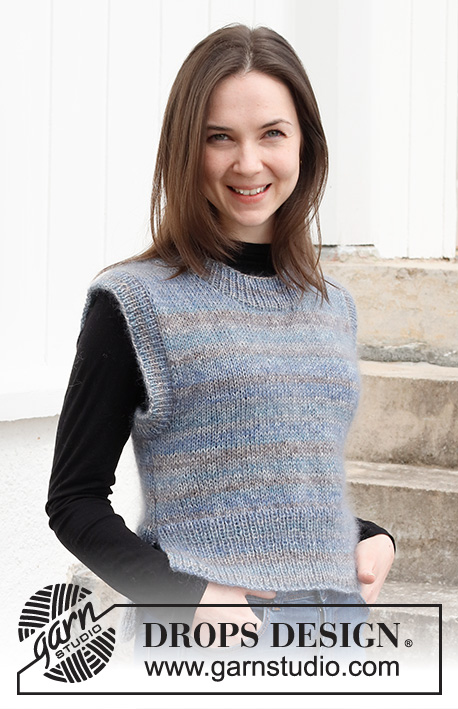
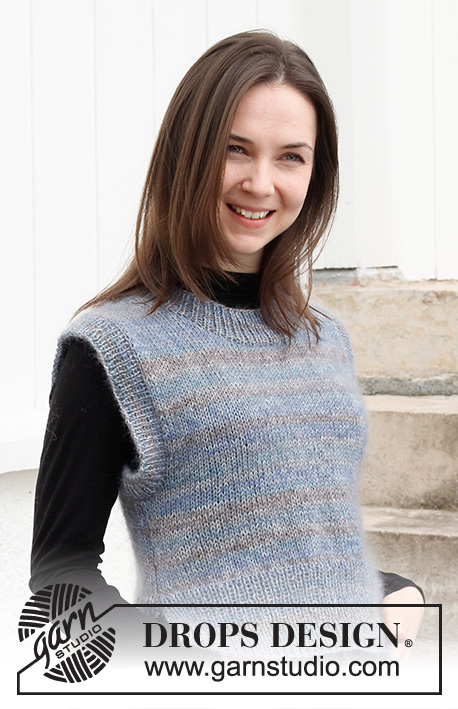


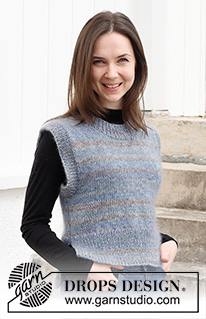
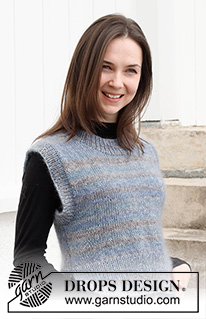



































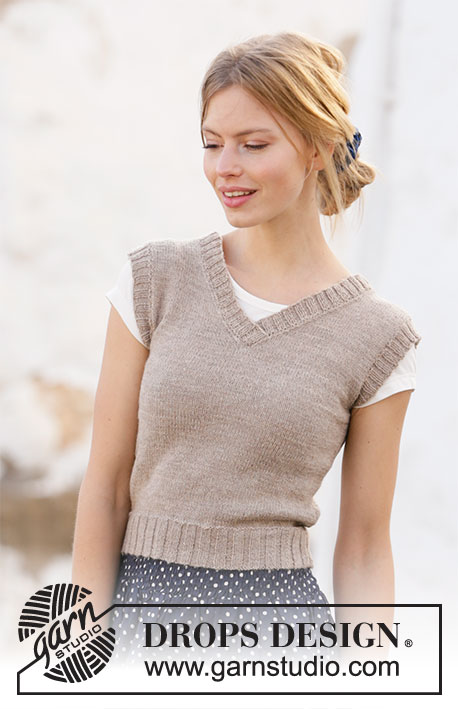






Comments / Questions (21)
Ich bin sehr zierlich und würde das Modell gerne in xxs / xs arbeiten. Die Schulterbreite sollte bei ca 36 cm liegen, der Bund bei 40 cm. Wie kann ich die Maschenzahl reduzieren oder soll ich einfach nur (deutlich) dünnere Nadeln verwenden?
16.04.2024 - 23:12DROPS Design answered:
Liebe Frau Rieger, hier finden Sie alle unsere Anleitungen für Westen und Pullunder für XS, vielleicht finden Sie ein passendes Modell. Viel Spaß beim Stricken!
17.04.2024 - 08:31Det vil være rart, hvis man kunne se hvad størrelse modellerne har på, så man har et udgangspunkt. Kan dette ses et sted? :)
03.01.2024 - 11:59DROPS Design answered:
Hei Sabina. Modellene er som regel str. S. Men det beste er å se på målskisse og se på målene der. mvh DROPS Design
08.01.2024 - 14:37Hej, Jeg er nået til at skulle lukke af til ærmegab på forstykket. Dog forstår jeg ikke hvordan jeg skal lukke 3 masker af på en gang, og bagefter 2 masker på en gang. Ud over det, skal jeg så strikke ret indtil jeg kommer til de sidste 6 masker også lukke af der (dog omvendt), eller skal jeg strikke pinden ud også lukke af næste gang på vrang? Ville bare tro, at ærmerne så ikke bliver overfor hinanden :D På forhånd tak for hjælpen :D
27.05.2023 - 15:43DROPS Design answered:
Hei Cassandra Du feller av fra retten i den ene siden og fra vrangen i den andre siden. I f.eks str. S har du 74 masker. Du feller først av 3 masker fra retten i den ene siden, strikk pinnen ut, snu, fell 3 nye masker i den andre siden (fra vrangen). Strikk pinnnen ut, snu og nå felles det 2 masker, strikk pinnen ut, snu og felle 2 masker fra vrangen, strikk pinnen ut, snu, fell 1 maske, strikk pinnen ut, snu, fell 1 maske, strikk pinnen ut = 62 masker. mvh DROPS Design
30.05.2023 - 09:31Hej! Det ser ud til der mangler tekst forklaringen til rygstykket, efter delen om ærmegab står der: "Strik videre til arbejdet måler 44-46-48-50-52-54 cm (der er ca 4 cm tilbage til færdigt mål)." Burde det være 10 cm mere end det var for forstykket? Så der er ca 20-20-22-22-24-24 cm tilbage? På forhånd tak. Mvh, Helena
18.09.2022 - 12:27DROPS Design answered:
Hei Helena. Bakstykket er 4 cm lengre enn forstykket. Disse 4 cm strikkes i begynnelsen (vrangborden = 14 cm). På forstykket felles det til hals ca 10-14 cm før ferdig mål, men på bakstykket felles det til hals når det er ca 4 cm igjen. mvh DROPS Design
19.09.2022 - 13:44Where do I find number of stitches to cast on, etc
05.06.2022 - 17:36DROPS Design answered:
Dear Carol, as seen in the FRONT: Cast on 89 (for size S) -97 (for size M) -103 (for size L) -111 (for size XL) -121 (for size XXL)-131 (for size XXXL) stitches. Our patterns are written for several sizes at once, so you need to select the number depending on the size you are working. Check out the following lesson to help you better understand our patterns: https://www.garnstudio.com/lesson.php?id=79&cid=19 . Happy knitting!
05.06.2022 - 20:54Le diminuzioni per gli Scalfi vanno fatte tutti i ferri, o solo sul diritto del lavoro? e quindi un ferro si e uno no. Grazie
05.04.2022 - 14:18DROPS Design answered:
Buonasera Anna, le diminuzioni per gli scalfi si lavorano su tutti i ferri. Buon lavoro!
05.04.2022 - 19:12Le diminuzioni per gli Scalfi vanno fatte tutti i ferri o solo sul diritto del lavoro? e quindi un ferro si e uno no
03.04.2022 - 22:49DROPS Design answered:
Buonasera Anna, le diminuzioni per gli scalfi si lavorano su tutti i ferri. Buon lavoro!
05.04.2022 - 19:12Buonasera, mia nipote vorrebbe che le realizzassi questo modello color blu reale 108, a quale colore kid-silk potrei abbinarlo? Grazie Gabriella
06.01.2022 - 16:10DROPS Design answered:
Buongiorno Gabriella, potrebbe utilizzare il colore kid-silk n° 39 blu tempesta oppure n° 08 blu ghiaccio; in ogni caso può chiedere al suo rivenditore delle foto degli abbinamenti per poter decidere meglio. Buon lavoro!
08.01.2022 - 13:17Hermoso modelo!,,
17.06.2021 - 21:33Det står i oppskrift at første pinne på bråtet skal strikkes rett? Er det noken grunn til dette, eller kan ein strikke de den med en rett og en vrang slik som resten?
01.05.2021 - 09:33DROPS Design answered:
Hei Monika, Vi foreslår en pinne rett for å lage en smal kant, men du kan gjerne begynne med vrangbord med en gang hvis du vil. God fornøyelse!
03.05.2021 - 07:50